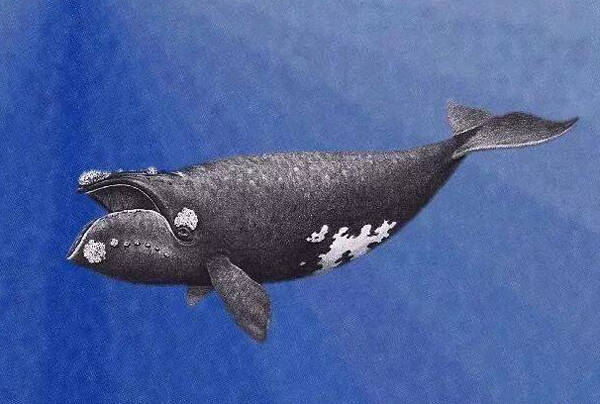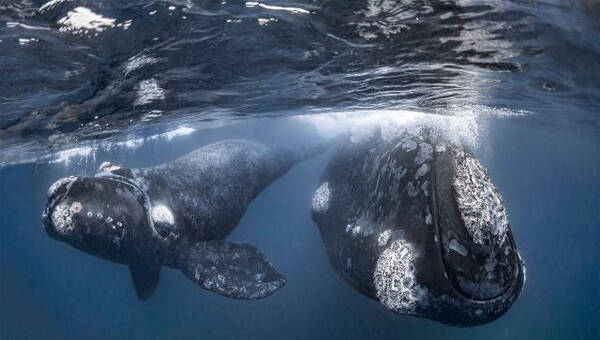Eubalaena glacialisBorowski
IUCN
LCBasic Information
Scientific classification
- name:Eubalaena glacialisBorowski
- Scientific Name:Eubalaena glacialis Borowski
- Outline:Cetacea
- Family:R.whale
Vital signs
- length:About 15 meters
- Weight:50-80 tons
- lifetime:50-80 years
Feature
Listed as one of the six whale species in the world that are in danger of extinction
Distribution and Habitat
North Atlantic right whales live in the North Atlantic Ocean, including Canada, the United States, Norway, Sweden, Denmark, the Netherlands, Germany, Belgium, Greenland and Iceland.
North Atlantic right whales swim to the south to reproduce in winter every year, and swim to the north to feed in summer. When they go south, some pass through the Sea of Okhotsk and the Sea of Japan and enter the Yellow Sea and East China Sea of China. Others go south to the Taiwan Sea and the South China Sea. In summer, they leave the Chinese waters and head north.
Appearance
A fully mature North Atlantic right whale can reach 15 meters in length and weigh 50-80 tons. Its body color is blue-black or black.
Its upper jaw is slender and curved downward in an arch shape, and the lower jaw protrudes upward on both sides. There is a large oval keratin tumor on the top of the front end of the upper jaw, and there is also a row of smaller keratin tumors in front of the blowhole and on both sides of the upper and lower jaws. The ventral surface of the body is smooth and has no wrinkles. The head length of the North Atlantic right whale is about one-fourth of the body length, and the maxilla and intermaxilla of the skull extend forward in an arch shape. It also has a peculiarly shaped keratin tumor, commonly known as a "hat". Its irregular shape is formed by abnormal proliferation of the epidermis. The largest tumor is located at the front end of the upper jaw, and the second largest is located on both sides of the front end of the lower jaw and behind
Details
The North Atlantic right whale (Scientific name: Eubalaena glacialis Borowski) is also known as the North Atlantic Right whale. Due to excessive hunting around the world, it is on the verge of extinction and has been listed as one of the six whales in danger of extinction in the world.

The North Atlantic right whale is a rare cold-temperate baleen whale in the ocean. It swims slowly, with a migration speed of 2-3 nautical miles per hour and only about 5 nautical miles when escaping. The diving depth does not exceed 50 meters and lasts for 10-20 minutes. North Atlantic right whales usually swim alone or in groups of 2-3, and approach bays and islands. They swim very slowly, and when they exhale, they spray two mist columns up to 4-6 meters high. When they dive deeply, they lift their tail fins above the water surface. When swimming, they usually breathe 2-3 times per minute. When they exhale, they spray a 4-8 meter high mist column from each of the two blowholes. When they fall, they are shaped like umbrellas, and they look like flowers scattered by fairies. After several shallow dives, there will be a deep dive lasting 10-20 minutes, but the depth does not exceed 50 meters.
The diet of North Atlantic right whales is relatively narrow, mainly feeding on small planktonic crustaceans and small mollusks among the copepods of crustaceans, mainly stinging dart fleas, long-bellied sword fleas and barrel fleas. North Atlantic right whales also eat krill larvae and occasionally other groups of plankton larvae. North Atlantic right whales usually dive deep to feed, and each dive lasts 8-12 minutes. But when prey is highly concentrated on the sea surface, they occasionally feed on the surface. When feeding, they open their mouths wide and swallow the seawater and food into their mouths, then close their mouths slightly and use their tongues to squeeze the seawater out from between their long whiskers, and then roll up the filtered food and eat it. Because the width of its pharynx is only 6-7 cm, large fish swallowed into its mouth cannot be swallowed into its stomach and have to be spit out again.

The estrus period of the North Atlantic right whale is about half a year. It usually mates from February to April. The gestation period of females is about 12 months. The North Atlantic right whale reproduces once every 3-6 years on average, giving birth to one calf per litter. The newborn is 4-4.6 meters long and weighs about 1,400 kilograms. When weaned, the body is about 10 meters long. The length of female whales at sexual maturity is 15.8 meters, and that of male whales is 15.2 meters. Female whales give birth every two years or more. The length of sexually mature individuals in the North Pacific is 14-15 meters for male whales and 13-15 meters for female whales.
The North Atlantic right whale moves slowly and has a docile temperament, so it is easier to catch. It is one of the earliest whales to be hunted and is often killed in large numbers. The number of North Atlantic right whales is very small, with only about 100 in the North Atlantic in the northern hemisphere, slightly more in the North Pacific, and even fewer in the southern hemisphere, with less than 300 North Atlantic right whales.
Listed in Appendix I of CITES.
Listed as a Class II protected animal in China.
The IUCN Red List is listed as: Endangered (EN)
Protect wild animals and stop eating game.
Maintaining ecological balance is everyone's responsibility!








